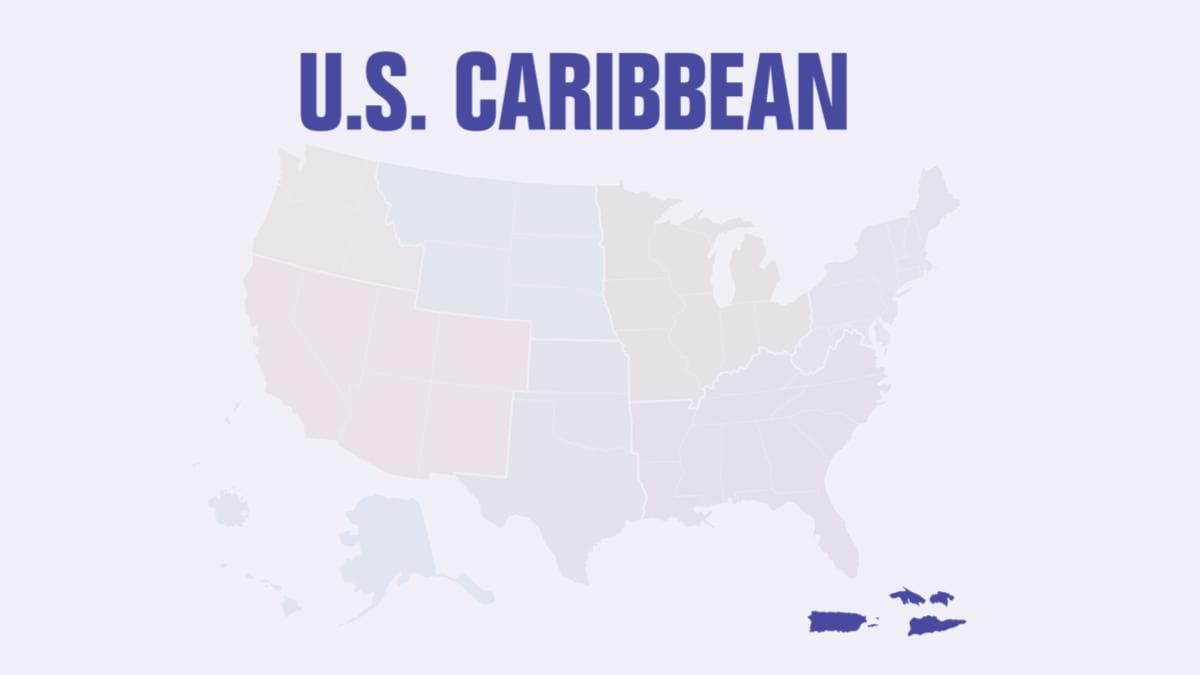At a glance
Each region of the United States experiences climate change and its impacts on health differently. Learn more about climate related health impacts in U.S. Caribbean.

Temperature-related death and illness
Weather stations indicate that the annual number of days with temperatures above 90°F has increased over the last four and a half decades. A number of extreme temperature events occurred in Puerto Rico during the summers of 2012–2014, when most days exceeded 90°F. During San Juan's record heat episode in 2012, stroke and cardiovascular disease were the primary causes of death due, in part, to the elevated summer temperatures in the municipalities of San Juan and Bayamón.
Several factors contribute to heat risk and sensitivity, including age, pregnancy, poverty, disability, chronic health conditions, and outdoor labor. Cooling indoor environments helps to lessen the impact of heatwaves, but energy demands on a crumbling power infrastructure, as well as rising costs of living, create climate risks associated with inequality, as only a section of society will be able to afford cooling equipment.
Air quality impacts
In the U.S. Caribbean, dust particles carried across the Atlantic from the Sahara, mostly during summer, affect climate, weather, and ecosystems, including coral reefs, forests, and human populations. While vital for the ecosystem, the dust is associated with increased cardiovascular and respiratory risks. It also has been linked to an increased risk of emergency room visits and hospitalizations related to asthma in children in Trinidad and Tobago, Guadeloupe, and Grenada. As humidity and temperatures rise, the abundance of mold and spores impacts air quality and, thus, respiratory non-communicable diseases.
Extreme events
Extreme events pose significant risks to life, property, conservation, agriculture, and the economy in the Caribbean. Further, some extreme events, such as flooding and droughts, are projected to increase in frequency and intensity as climate change worsens. This is particularly concerning for the U.S. Caribbean as there is a high concentration of population and critical infrastructure in low-lying coastal areas, which increases vulnerability to sea level rise and storm surge and magnifies the effects of coastal flooding and beach erosion.
The health impacts across the Caribbean Small Island Developing States (SIDS) span a large range, including physical injury from wind and water during hurricane passage and during post-event rescue and cleanup efforts, heat-related injury due to loss of access to air conditioning and fans, inability to manage chronic disease due to loss of access to electrical power or medical services, and increased exposure to vector-borne diseases and diseases from contaminated water. Mental health impacts are also notable, as most survivors experience a high degree of psychological trauma during and after hurricane events.
Vector-borne diseases
Vector-borne diseases in the Caribbean, such as dengue, Zika, and chikungunya, are mostly transmitted by the Aedes aegypti, Aedes albopictus, and Culex mosquitoes. Warmer conditions facilitate the expansion of mosquito populations and potentially increase their capacity to transmit diseases.
There are also emerging vector-borne diseases, such as leptospirosis, whose spread has been associated with flood-prone areas, heavy rainfall, and higher temperatures. Extreme weather events such as tropical storms, heavy rainfall, and floods are expected to result in an upsurge in the number and magnitude of leptospirosis outbreaks.
Factors in the U.S. Caribbean that favor vector-borne outbreaks include climate change, inequality, poverty, serotype profile (virus variation), immunity, deficient water and waste management, and lack of community awareness.
Water-related illness
Coastal communities’ water supplies are threatened by rising temperatures, sea level rise, saltwater intrusion, extreme drought, and flooding. Moreover, traditional rainwater catchment systems are becoming unreliable and threatened as precipitation patterns are changing. Studies conducted after hurricanes have found water pollution, disease vectors, and bacteria in the drinking water supply, all of which are expected to worsen with the expected impacts of climate change, thus affecting livelihood security. Puerto Rico and the USVI are projected to lose 3.6% and 4.6% of their total coastal land area, respectively. Were such a rise to take place, Puerto Rico’s critical infrastructure near the coast would be negatively impacted, including drinking water pipelines, pump stations, sanitary pipelines, and one wastewater treatment plant. In the USVI, infrastructure and historical buildings in the inundation zone include pipelines for water and sewage.
Food safety, nutrition, and distribution
Studies show that major shifts in fisheries distribution, coupled with changes in marine habitats such as coral reefs, adversely affect food security, shoreline protection, and economies throughout the Caribbean.
Additionally, increases in average temperature and extreme heat events will likely have detrimental effects on agricultural operations throughout the U.S. Caribbean region. Climate change affects cattle ranchers and dairy farmers in the U.S. Caribbean by reducing rangeland productivity, causing a shortage of nutritional feed, increasing heat stress on animals, and increasing energy costs for cooling.
Mental health and well-being
Mental health impacts are also notable in the Caribbean Small Island Developing States (SIDS), as most survivors experience a high degree of psychological trauma during and after hurricane events. In the aftermath of Hurricane Maria, many older adults in Puerto Rico experienced unmet needs that contributed to declining physical and emotional health, inadequate management of noncommunicable diseases, social isolation, financial strain, environmental health issues, and excess mortality. High levels of post-traumatic stress disorder (PTSD), depressive symptoms, and disaster-related stressors were also evident.
Populations of concern
U.S. Caribbean societies, with their multiethnic and multiracial makeup of high proportions of people of African and Indigenous descent, are more vulnerable to climate-related risks due to economic policies and social systems, varying levels of educational attainment, unemployment, poverty, out-migration, older-age demographics, food insecurity, colonialism, and unjust historical treatment.
Urban areas are particularly vulnerable to extreme heat events, given the concentration of built structures, traffic, and other factors that drive the urban heat island (UHI) effect. Since the middle of the last century, urbanization and population growth have increased the UHI effects in San Juan, Puerto Rico. Such effects are becoming even more life-threatening with a growing and more vulnerable aging population.
